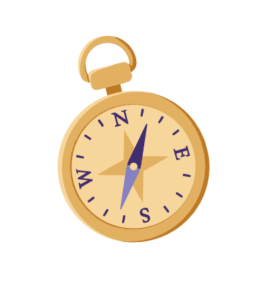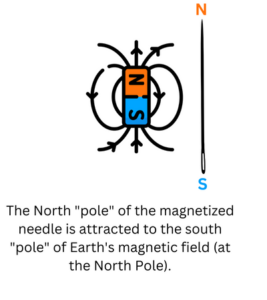
Magnetic Marvels: Build Your Own DIY Compass!
Description:
Embark on a magnetic adventure with our DIY Compass experiment! In this fun and simple activity, you’ll create your very own compass using household materials. You’ll learn about the fascinating world of magnets and how they can help us find our way. Get ready to explore magnetic forces and discover the power of navigation!
Scientific Principles:
- Magnetism: This experiment will introduce the concept of magnetism, where magnets have a special property that attracts certain materials like iron and steel. You’ll learn how magnets have a north pole and a south pole, and how they interact with the Earth’s magnetic field.
- Magnetic Field and Navigation: You’ll explore how the Earth’s magnetic field influences the movement of a compass needle. The needle aligns itself with the magnetic field, pointing north and helping us navigate.

Materials Needed:
- Small circular magnet (e.g., refrigerator magnet or magnetic button)
- Small piece of cork or foam
- Bowl of water
- Small sewing needle
- Tape
- Optional: Paper and pen for recording observations
Equipment Difficulty Rating:
Obtaining the equipment: 2/5 (Most materials can be found at home.)
Completing the experiment: 2/5 (It’s straightforward but requires careful handling of the needle.)
Steps:
- Get Ready: Find a clean and flat surface to conduct the experiment. Gather all the materials in front of you.
- Prepare the Cork or Foam: Take the small piece of cork or foam and place it in the bowl of water. Make sure it floats on the surface.
- Magnetize the Needle: Ask an adult to help you magnetize the sewing needle. Rub one end of the needle against the magnet in one direction around 20 times. This will help make it magnetic.
- Attach the Needle: Carefully place the magnetized end of the needle onto the piece of cork or foam. The other end of the needle should be hanging off the edge.
- Stabilize the Compass: Use a small piece of tape to secure the needle to the cork or foam. Make sure it is attached firmly, but avoid covering the magnetized end.
- Observe the Needle: Allow the cork or foam to float freely in the water. Watch as the needle settles and comes to rest. It will point in a certain direction.
- Record the Observation: If you have paper and a pen, draw a diagram of the compass and note the direction that the needle is pointing. This is your homemade compass indicating north!
- Test the Compass: To check if your compass is working correctly, rotate the bowl slowly. Notice how the needle follows the movement, always pointing in the same direction.
- Explore and Discover: Take your DIY compass on a journey around your home or backyard. Observe how the needle consistently points in the same direction, helping you find your way!
And there you have it! You’ve created your very own DIY Compass. Enjoy exploring the magnetic world and discovering the power of navigation. Have fun using your compass to find north and embark on exciting adventures!
Simple Explanation:
In our DIY Compass experiment, we use a special needle and a floating cork or foam to make our own compass. The needle is like a tiny magnet, and it likes to point in a certain direction because of the Earth’s magnetic field. When we place the needle on the cork or foam and let it float in water, it aligns itself with the Earth’s magnetic field and points us towards the north. Isn’t it cool how magnets can help us find our way?


Detailed Explanation:
During the DIY Compass experiment, we delve into the science of magnetism and the Earth’s magnetic field. The Earth itself acts like a giant magnet with a north pole and a south pole. These magnetic poles create an invisible force field around the Earth, called the magnetic field.
When we magnetize the needle and attach it to the cork or foam, it becomes a tiny magnet too. Magnets have two ends: a north-seeking end (north pole) and a south-seeking end (south pole). These ends have opposite charges and are attracted to each other.
When we place the magnetized needle on the floating cork or foam, the needle aligns itself with the Earth’s magnetic field. The north-seeking end of the needle is attracted to the Earth’s magnetic south pole, which is located near the geographic North Pole. So, the needle points us towards the north direction.
The DIY Compass demonstrates how magnets interact with the Earth’s magnetic field, providing a simple way to determine direction. It’s an exciting exploration of magnetic forces and how they help us navigate our surroundings.

